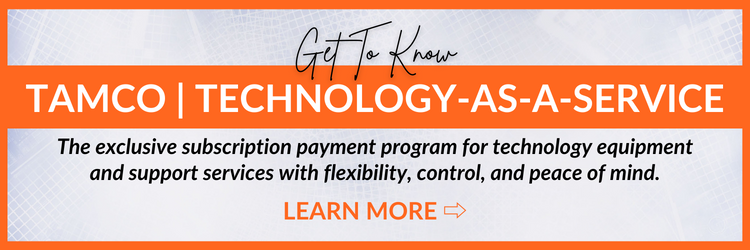[Video Transcript Below]
Why You Do Not Want To Own Technology Solutions
Historically, almost all technology solution installations for organizations have been paid for with an upfront purchase or a financing arrangement that resulted in ownership.
However, in today’s marketplace, three key factors, in particular, should make any organization want to avoid ownership and look for a better way to manage their technology needs. Let’s discuss . . .
- The Economics of Ownership
- Rapid Advancement of Technology
- Maintaining Essential Use/Mission Critical Solutions
1. Economics of Ownership
Technology Is a Non-Revenue Generating Asset
Starting with the economics of ownership, organizations generally want to own assets that appreciate value or generate revenue. However, we need to recognize that most technology systems are non-revenue-generating assets. Yes, they are important, probably even critical. Security systems, communications equipment, network infrastructure, and more. But the servers, the cameras, the displays, and all the components of any given solution while necessary, do not in and of themselves produce revenue. In fact, these solutions depreciate in value and they do so quickly.
Understanding Non-Recoverable Costs
Digging a little deeper on this point, one significant reason technology equipment depreciates so fast is because of non-recoverable costs. Chances are no one has ever discussed non-recoverable costs with you, so let’s elaborate a bit on this important point.
Non-recoverable costs include solution components like design and installation charges, licensing, integrator margin, manufacturer margin, training, and more. These costs are non-recoverable because the day after a solution is installed the value associated with these components has basically vanished.
But more importantly, non-recoverable costs amount to a significant portion of the total price of a technology solution. Frequently 50% or more of your purchase price is attributable to non-recoverable cost items. So you can see why the high level of non-recoverable costs contributes to the rapid depreciation mentioned a moment ago.
Now understand, non-recoverable costs are not due to unscrupulous or deceitful sales tactics on the part of technology integrators. These costs are simply a normal part of the pricing structure of any technology solution. But over the years customers have shared with us that no one has discussed this concept with them as something that may influence their purchase decisions. And when made aware, most customers agree, they do not want to own assets with such a high level of non-recoverable costs.
2. Rapid Advancement of Technology
The second factor to consider is how quickly technology is changing. The pace of change itself has actually accelerated causing many technology solutions to be replaced or upgraded much sooner than they have been in the past. And we only need to look at the money that major manufacturers put into their research and development budgets to realize this change will continue.
Look at Major Manufacturer's R&D Budgets
View the publicly available financial reports from companies like Cisco, Polycom, Barco, Bosch, Axis Communications, FLIR, Microsoft, and many many others. You will see that year over year they consistently spend billions and billions of dollars on R&D. Frequently allocating anywhere from 8% to 28% of their total revenue to developing new products and technologies to bring to market and replace existing solutions.
Recognizing this accelerating change is guaranteed, how can any organization feel good about burning through their hard-earned capital to own an expensive technology solution for which they will have better options within three years, two years, or less? And for organizations that need to have the latest technology, is it financially prudent for them to do so through repeated large capital purchases?
The solutions themselves are undoubtedly necessary, but ultimately, organizations need a better way to manage the dynamic nature of technology evolution.
3. Maintaining Essential Use/Mission Critical Solutions
The third factor draws on the reality that technology systems are no longer a nicety or an option. Most solutions are now an essential part of the fabric of any organization’s operations. They are not only absolutely necessary but they absolutely need to be functional. There is limited and possibly even no tolerance for maintenance issues, part failures, configuration headaches, or unexpected problems causing downtime.
While the easy resolution is to ensure the integrator selling the technology system provides a comprehensive package of ongoing warranty, maintenance, support, and monitoring services for any installation, the reality is few integrators provide this level of assurance with an ownership purchase. And perhaps more interesting, even when those components are available, most customers recognize the need but feel financially tapped out simply by the purchase of the technology solution itself.
Unfortunately, customers knowingly or unknowingly forego these important assurances and subject themselves to the various risks of hoping their solutions stay functional all the time for as long as they own them.
Again, customers need a better way to address this element of risk associated with their indispensable technology systems.
To Summarize . . .
- Economics of Ownership
- Rapid Evolution of Technology
- Lifetime Solution Maintenance
The economics of ownership expose some very real financial pitfalls when it comes to owning technology solutions. Exponential technology change makes ownership an almost impossible way to remain current with technology solutions. And the risks of ensuring systems are always up and running and performing as needed are not an additional burden organizations can afford to be distracted with.
Collectively, these factors make it difficult to build a case that owning commercial use technology solutions today is a smart decision.
What Is The Alternative To Owning Technology Solutions?
Technology-As-A-Service Subscription Solutions
Technology-as-a- Service subscription solutions address all of these issues and more.


